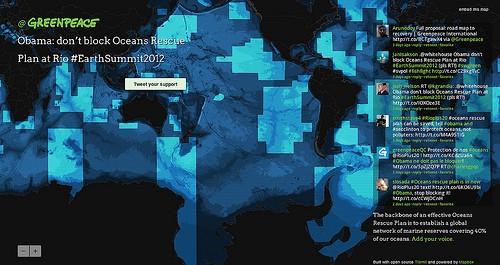As part of Greenpeace’s campaign to create a global marine reserve network and their advocacy this week at the United Nation’s Conference for Sustainable Development Rio+20, they’ve launched a social media map showing what this network would look like in an effort to make the objectives of the Earth Summit more concrete. The map site is a timely reminder revisiting the marine reserve network proposal, first published in 2006.

Based on a light-weight map, the site deploys Twitter functionalities that encourage the viewer to spread the word. The rotating feed on the right side searches for recent tweets about the site, showing the viewer what other people have been saying.
How the map site was built
The reserve map was designed in TileMill with data from the Greenpeace report, and is hosted on MapBox. The recent compositing development in TileMill allows for the transparent and luminous color effect that you see in the map. This site makes use of the map site template, which makes it easy to incorporate Wax and Modest Maps into the website.
For more information on the marine reserve plan, visit Greenpeace’s site.
What we're doing.
Latest
